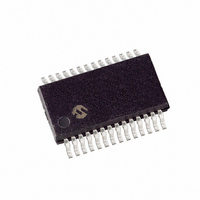PIC16F870T-I/SS Microchip Technology, PIC16F870T-I/SS Datasheet - Page 10

PIC16F870T-I/SS
Manufacturer Part Number
PIC16F870T-I/SS
Description
IC MCU FLASH 2KX14 EE 28SSOP
Manufacturer
Microchip Technology
Series
PIC® 16Fr
Datasheets
1.PIC16F616T-ISL.pdf
(8 pages)
2.PIC16F688T-ISL.pdf
(688 pages)
3.PIC16F870-ISO.pdf
(172 pages)
4.PIC16F870-ISO.pdf
(6 pages)
Specifications of PIC16F870T-I/SS
Core Processor
PIC
Core Size
8-Bit
Speed
20MHz
Connectivity
UART/USART
Peripherals
Brown-out Detect/Reset, POR, PWM, WDT
Number Of I /o
22
Program Memory Size
3.5KB (2K x 14)
Program Memory Type
FLASH
Eeprom Size
64 x 8
Ram Size
128 x 8
Voltage - Supply (vcc/vdd)
4 V ~ 5.5 V
Data Converters
A/D 5x10b
Oscillator Type
External
Operating Temperature
-40°C ~ 85°C
Package / Case
28-SSOP
For Use With
I3-DB16F871 - BOARD DAUGHTER ICEPIC3
Lead Free Status / RoHS Status
Lead free / RoHS Compliant
- PIC16F616T-ISL PDF datasheet
- PIC16F688T-ISL PDF datasheet #2
- PIC16F870-ISO PDF datasheet #3
- PIC16F870-ISO PDF datasheet #4
- Current page: 10 of 172
- Download datasheet (4Mb)
PIC16F870/871
TABLE 1-2:
DS30569B-page 8
OSC1/CLKI
OSC2/CLKO
MCLR/V
RA0/AN0
RA1/AN1
RA2/AN2/V
RA3/AN3/V
RA4/T0CKI
RA5/AN4
RB0/INT
RB1
RB2
RB3/PGM
RB4
RB5
RB6/PGC
RB7/PGD
RC0/T1OSO/T1CKI
RC1/T1OSI
RC2/CCP1
RC3
RC4
RC5
RC6/TX/CK
RC7/RX/DT
Legend:
Note 1:
Pin Name
2:
3:
4:
PP
/THV
REF
REF
I = input
— = Not used
This buffer is a Schmitt Trigger input when configured as an external interrupt or LVP mode.
This buffer is a Schmitt Trigger input when used in Serial Programming mode.
This buffer is a Schmitt Trigger input when configured as general purpose I/O and a TTL input when used in the Parallel
Slave Port mode (for interfacing to a microprocessor bus).
This buffer is a Schmitt Trigger input when configured in RC Oscillator mode and a CMOS input otherwise.
-
+
PIC16F871 PINOUT DESCRIPTION
Pin#
DIP
13
14
33
34
35
36
37
38
39
40
15
16
17
18
23
24
25
26
1
2
3
4
5
6
7
PLCC
Pin#
14
15
36
37
38
39
41
42
43
44
16
18
20
25
26
27
29
19
O = output
TTL = TTL input
2
3
4
5
6
7
8
QFP
Pin#
30
31
18
19
20
21
22
23
24
10
11
14
15
16
17
32
35
36
37
42
43
44
8
9
1
I/O/P
Type
I/O
I/O
I/O
I/O
I/O
I/O
I/O
I/O
I/O
I/O
I/O
I/O
I/O
I/O
I/O
I/O
I/O
I/O
I/O
I/O
I/O
I/O
I/P
O
I
I/O = input/output
ST = Schmitt Trigger input
ST/CMOS
TTL/ST
TTL/ST
TTL/ST
TTL/ST
Buffer
Type
TTL
TTL
TTL
TTL
TTL
TTL
TTL
TTL
TTL
ST
ST
ST
ST
ST
ST
ST
ST
ST
ST
—
(1)
(1)
(2)
(2)
(4)
Oscillator crystal input/external clock source input.
Oscillator crystal output. Connects to crystal or resonator in
Crystal Oscillator mode. In RC mode, OSC2 pin outputs CLKO,
which has 1/4 the frequency of OSC1, and denotes the
instruction cycle rate.
Master Clear (Reset) input or programming voltage input or
High Voltage Test mode control. This pin is an active low
RESET to the device.
PORTA is a bi-directional I/O port.
PORTB is a bi-directional I/O port. PORTB can be software
programmed for internal weak pull-up on all inputs.
PORTC is a bi-directional I/O port.
RA0 can also be analog input 0.
RA1 can also be analog input 1.
RA2 can also be analog input 2 or negative analog
reference voltage.
RA3 can also be analog input 3 or positive analog
reference voltage.
RA4 can also be the clock input to the Timer0
timer/counter. Output is open drain type.
RA5 can also be analog input 4.
RB0 can also be the external interrupt pin.
RB3 can also be the low voltage programming input.
Interrupt-on-change pin.
Interrupt-on-change pin.
Interrupt-on-change pin or In-Circuit Debugger pin.
Serial programming clock.
Interrupt-on-change pin or In-Circuit Debugger pin.
Serial programming data.
RC0 can also be the Timer1 oscillator output or a Timer1
clock input.
RC1 can also be the Timer1 oscillator input.
RC2 can also be the Capture1 input/Compare1 output/
PWM1 output.
RC6 can also be the USART Asynchronous Transmit or
Synchronous Clock.
RC7 can also be the USART Asynchronous Receive or
Synchronous Data.
P = power
Description
2003 Microchip Technology Inc.
Related parts for PIC16F870T-I/SS
Image
Part Number
Description
Manufacturer
Datasheet
Request
R

Part Number:
Description:
IC MCU FLASH 2KX14 EE 28SOIC
Manufacturer:
Microchip Technology
Datasheet:

Part Number:
Description:
IC MCU FLASH 2KX14 EE 28DIP
Manufacturer:
Microchip Technology
Datasheet:

Part Number:
Description:
IC MCU FLASH 2KX14 EE 28SSOP
Manufacturer:
Microchip Technology
Datasheet:

Part Number:
Description:
IC MCU CMOS 20MHZ 2K FLASH 28DIP
Manufacturer:
Microchip Technology
Datasheet:

Part Number:
Description:
IC MCU CMOS 20MHZ 2K FLSH 28SSOP
Manufacturer:
Microchip Technology
Datasheet:

Part Number:
Description:
28 PIN, 3.5KB ENH FLASH, 128 RAM, 22 I/O,
Manufacturer:
Microchip Technology
Datasheet:

Part Number:
Description:
IC MCU FLASH 4KX14 EEPROM 18DIP
Manufacturer:
Microchip Technology
Datasheet:

Part Number:
Description:
IC MCU FLASH 4KX14 EEPROM 18SOIC
Manufacturer:
Microchip Technology
Datasheet:

Part Number:
Description:
IC MCU FLASH 4KX14 EEPROM 20SSOP
Manufacturer:
Microchip Technology
Datasheet:

Part Number:
Description:
IC MCU FLASH 4KX14 EEPROM 28QFN
Manufacturer:
Microchip Technology
Datasheet:

Part Number:
Description:
IC MCU FLASH 4KX14 EEPROM 18SOIC
Manufacturer:
Microchip Technology
Datasheet:

Part Number:
Description:
IC MCU FLASH 4KX14 EEPROM 20SSOP
Manufacturer:
Microchip Technology
Datasheet:

Part Number:
Description:
IC MCU FLASH 4KX14 EEPROM 28QFN
Manufacturer:
Microchip Technology
Datasheet:

Part Number:
Description:
IC,MICROCONTROLLER,8-BIT,PIC CPU,CMOS,DIP,18PIN,PLASTIC
Manufacturer:
Microchip Technology
Datasheet:

Part Number:
Description:
IC, 8BIT MCU, PIC16F, 32MHZ, SOIC-18
Manufacturer:
Microchip Technology
Datasheet:










